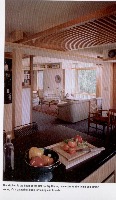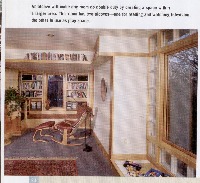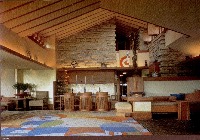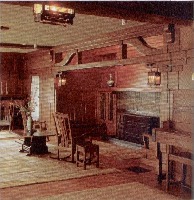Open plan living is a vast improvement on life in a box -- or in a series of boxes, which is what describes most traditional houses, unfortunately.
But it’s not enough just to be “open plan.” The biggest open plan space is just a field, right? Good open-plan living still requires a delineation of spaces within the larger space – it’s just more difficult for the designer to ensure the right degree of separation between the sub-spaces, and the right amount of integration of each sub-space with the main space.
 In a well-designed open space, each space will have its own character, and will flow easily and comfortably into other spaces – especially if the spaces are successfully “nested.” It should feel natural, not forced, with each space retaining its own character within the larger space, but still being a part of it. Done properly, the “separation” or division of spaces gives the right feelings of liberation or enclosure appropriate to the space.
In a well-designed open space, each space will have its own character, and will flow easily and comfortably into other spaces – especially if the spaces are successfully “nested.” It should feel natural, not forced, with each space retaining its own character within the larger space, but still being a part of it. Done properly, the “separation” or division of spaces gives the right feelings of liberation or enclosure appropriate to the space.
It’s important that the definition of each each space within the larger whole is done a subtle manner so as to avoid there simply being a space like 'one large barn.' Some popular methods of achieving this separation are:
- different floor coverings in different space;
- changes in floor level between spaces;
- furnishing layouts;
- the use of sliding or folding 'screens';
- the use of room proportions and wall returns to break up a larger space into smaller sub-spaces;
- posts and the like between spaces;
- changes in window and door layouts, e.g., a french door layout in one part of a space, and perhaps clerestory windows in the other;
The method by which the separation is achieved is usually dependent on the extent and quality of the spatial separation required.
All these methods of suggesting separation of spaces, from subtle to obvious, can be used in virtually every open space. In fact, one of the best places to see these methods in action "out in the wild" is in some of the best-designed bars and pubs, which use virtually every method there is to make small sociable, friendly spaces within a much larger whole. And here's one of the most effective methods to do this job:
- changes in ceiling height, including the use of lowered ceilings and lowered ceiling decks, like this:

 Which brings me to ceiling decks – a special kind of “overhead plane” that is among the very best ways to frame a space and begin making a home out of a house.
Which brings me to ceiling decks – a special kind of “overhead plane” that is among the very best ways to frame a space and begin making a home out of a house.
A ceiling deck is essentially a lowered “ceiling slab'” that you can see over, and in which you might have downlights, uplights and all your other services. (Great for future proofing because it's very easy to rewire!)
Your cunning designer can use ceiling decks to frame a space; to separate two spaces; to direct a view; and to give order and pleasurable contrast to a series of different-sized (or even same-sized) spaces.
If you've got them at the right heights, by playing off expected proportions with the unexpected proportions you build in, you can really begin to make a small space appear very much larger indeed.
And oddly enough, if the “decks” are done well and they become the primary ordering element of a space – the means by which all the space in your building is “read” – then your walls and all the home's other enclosures start to lose their importance. You’ve started to “break the box”-- reducing the sense of enclosure without removing the sense of place a home should give you.
Which maybe explains why you see them so rarely. Most modern designers like boxes. And they despise subtlety.
Ceiling decks offer a particularly subtle way both to 'frame a space' and to divide one space from another, but also – if you do them well -- lowered ceiling decks that 'frame' a space help to make that space and those around it appear larger than they are.
So basically, a lowered ceiling deck is simply a lowed or independent part of a ceiling, usually horizontal in the manner of an above-ground 'deck.'
Why do they work so well? Well, here's one reason--your "space bubble." See:
Each of us has our own personal space bubble--and, if we're with friends or family, a social space bubble within which we feel our personal space is contained.
Ceiling decks help "frame" these larger bubbles to give real presence to a space. And with lower decks, they offer a very good way of "squeezing down" a space bubble over eating areas for example, or at an entrance, which can then be "released" into a larger space--the contrast between the two making the large space feel larger and the lower space cosier.
This is simply a three-dimensional use of the technique of “containment” and then “release” used for centuries by the designers of Japanese landscapes and courtyard gardens. The same technique built in and updated.
A ceiling deck, or a lowered ceiling, can be in any style and suit houses of any era. Here are some examples of lowered ceilings, ceiling decks, ceiling dividers and “picture rails” (used to suggest a lowered ceiling) using different styles, and from different eras, all of them successful. See if you can see all the designers are hoping to achieve in each case:





























2 comments:
The people in the sketch are going to bang their heads on the ceiling decks.
Just a question, are the ceiling decks separate from the ceiling proper? If so they would accumulate dust and cobwebs and be difficult to clean. That would also be the case with the high ceilings.
Ah, no they won't, yes they often are, and no they don't.
Post a Comment